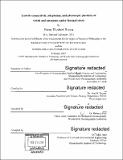Genetic connectivity, adaptation, and phenotypic plasticity of corals and anemones under thermal stress
Author(s)
Rivera, Hanny Elizabeth.
Download1102675161-MIT.pdf (18.61Mb)
Other Contributors
Joint Program in Oceanography/Applied Ocean Science and Engineering.
Massachusetts Institute of Technology. Department of Civil and Environmental Engineering.
Woods Hole Oceanographic Institution.
Advisor
Ann M. Tarrant.
Terms of use
Metadata
Show full item recordAbstract
Under global climate change, our oceans are warming at an unprecedented rate. Increased temperatures represent a severe source of stress for many marine organisms. This thesis aims to understand how corals and anemones respond to changing temperatures across different timescales and investigates mechanisms that can facilitate persistence in light of environmental change, from selection and adaptation across generations to phenotypic plasticity within a single individual's lifespan. In this context, I explore three case studies of thermal stress in corals and anemones. I begin with massive Porites lobata corals from the central Pacific. Here, reefs that are most affected by El Niflo, such as Jarvis and the northeast Phoenix Islands maintain genetic diversity indicating recruitment from nearby reefs may occur. Yet, they show significant genetic differentiation (FsT) from farther areas, suggesting this dispersal may be limited. Thermal variability in this region may also favor plasticity over adaptation, as we do not find differences in bleaching histories among genetic groups. Next, I investigate genetic connectivity and adaptation to chronically elevated temperatures across a natural temperature gradient within the Palauan archipelago. Combining genetic data and historical growth measurements from coral cores, I find that Palau's warmest reefs harbor unique genetic subpopulations of Porites lobata and find evidence for a genetic basis of their higher thermal tolerance. Lastly, I explore if parents can modulate parental effects to increase the thermal tolerance of their offspring over short time scales, using the estuarine anemone Nematostella vectensis. Indeed, I find parents exposed to increased temperatures quickly produce more thermally tolerant larvae. In fact, offspring from these Massachusetts parents show thermal thresholds that are indistinguishable from more southern populations. This thesis highlights the ability and potential of corals and anemones to persist under variable conditions over different timescales. Nevertheless, a compelling effort to reduce rates of warming worldwide will be imperative to the survival and integrity of key marine ecosystems such as coral reefs.
Description
Thesis: Ph. D., Joint Program in Oceanography/Applied Ocean Science and Engineering (Massachusetts Institute of Technology, Department of Civil and Environmental Engineering; and the Woods Hole Oceanographic Institution), 2019 Cataloged from PDF version of thesis. Includes bibliographical references.
Date issued
2019Department
Joint Program in Oceanography/Applied Ocean Science and Engineering; Massachusetts Institute of Technology. Department of Civil and Environmental Engineering; Woods Hole Oceanographic InstitutionPublisher
Massachusetts Institute of Technology
Keywords
Joint Program in Oceanography/Applied Ocean Science and Engineering., Civil and Environmental Engineering., Woods Hole Oceanographic Institution.